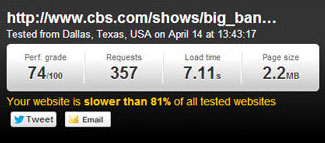Page Load Speed is Critical!
Google: "(We and) our users place a lot of value in speed... ...we've decided to take site speed into account in our search rankings."
Page Speed becomes even more important metric as the percentage of mobile device users grows (phones, iPad, etc.). "Light" pages are becoming essential for slower wireless connections and shared hotspots.
Search Engines seek the "best customer experience." Slow page load is an key factor in "bounce-back" - customer dissatisfaction with a specific search result, and immediately returning to the results page. High bounce rate sites can be penalized.
The Page Speed metric, unlike many others, can't be faked or manipulated by Search Engine Optimizers. Search Engines know a faster page is better 100% of the time.
ARE YOU LOSING 25-50% OF YOUR BUSINESS?
Akamai and JupiterResearch have called '4 Second' Page Load as the New Threshold of Acceptability. 40 percent of mobile shoppers will abandon an e-commerce site that doesn't load in four seconds. 50% of site visitors will abandon any site that doesn't load in ten seconds. Up to 10% of users may abandon a site that doesn't load in two seconds. Occasionally, even a site with average page weight will be loaded on a device with shared bandwidth or a lower speed connection (3G, etc.). Visitors may assume the site isn't working and navigate away, but a very "light" site may load in an acceptable timeframe.
PAY PER CLICK, DISPLAY ADS, AND SEO DISASTER
Do you use Pay Per Click Advertising or Interent Display Advertising (TV and Radio Stations, Etc.)? A slow site, could lose 25% of potential customers to bounce-backs! You could pay a 33% "Speed Tax" on every advertising dollar.
HOW FAST IS THIS PAGE?

The Screenshot above shows this page loaded in about one-half second on March 26, 2013, as tested by Pingdom Tools. Page load speed times vary due to server utilization, Internet traffic, etc. The test just before this one was about one second. Of course, the page will load a few milliseconds slower, now that I've included the Screenshot image above: Trade-offs between effective on-page communication and appearance and load time are omnipresent!
HOW MANY BILLIONS ARE THEY LOSING?

The Speed Test above comes from the "home" page for CBS televsion show "The Big Bang Theory" on April 14, 2013. During the 7+ seconds the page took to load, potential viewers of clips or episodes could easily decide the page wasn't working, start surfing on another tab while they are waiting, etc. Or, worse, be discourged from viewing shows at cbs.com (and seeing the ads!) because it's generally slow loading, and decide to be entertained by YouTube videos, etc. With a popular network like CBS, the potential lost revenue from this slow loading site could be in the billions. This cbs.com page made 357 http requests: That's just too many, given current technologies, and any page with that many http requests will load slowly and unreliably. Reducing the number of requests takes work, knowledge and discipline, but it's quite possible.
How To Speed Up Page Load:
Care. Know. Do Something. Sadly, many Web Developers don't know how quickly their pages load, don't understand what creates a fast page, or don't put the effort into fixing the problem. Ignorance and indifference are at the root of a slow page. Good Web Developers think about the effect on page speed with every line of code.
CSS-based Modern Coding: Older table-based, on-page-styling structure is inherently bulky and increasingly deprecated in HTML5 standards.
Many web images can be reduced with no loss of quality with Photoshop or similar editing software.
Use CSS, Vector Images or Font Sprites for icons (all vector technologies). Old-fashioned bitmap .jpg, .gif and .png icons can be up to 100 times larger, and worse image quality and responsiveness than their vector replacements. Unfortunately, bitmap navigation and icons are still very common.
Reduce server requests with Sprites (many small images melded into one) or combine internal CSS style sheets and JavaScript.
"Minify" HTML, CSS, Javascript - serve the user a version of these files with the formatting removed to save load time.
Use of a CDN (Amazon Cloudfront, YouTube etc.) to permit parallel processing of images and videos, geographical distributed hosting (host server near end user).
Good overview of pros and cons can be found at:
http://www.sitepoint.com/7-reasons-to-use-a-cdn/
http://www.sitepoint.com/7-reasons-not-to-use-a-cdn/